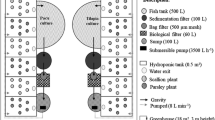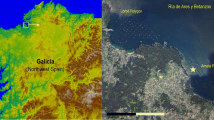Abstract
For rapid growth and appropriate pigmentation,Porphyra requires the constant availability of nutrients, especially in summer when temperate waters are generally nutrient depleted. Cultivation near salmon cages allows the alleviation of this seasonal depletion by using the significant loading of fishf arms, which is then valued (wastes become fertilisers) and managed (competition for nutrients between desirable algal crops and problem species associated with severe disturbances). Porphyra,being an extremely efficient nutrient pump, is an excellent candidate for integrated aquaculture for bioremediation and economic diversification. Frequent harvesting provides for constant removal of significant quantities of nutrients from coastal waters, and for production of seaweeds of commercial value. The production of P. yezoensis being limited in the Gulf of Maine, an assessment of the potential of seven native north-west Atlantic Porphyra species is presently in progress. To enable the production of conchospores for net seeding, the phenology of these species and the conditions for their vegetative conchocelis exponential growth, conchosporangium induction, and conchospore maturation were determined. The development of integrated aquaculture systems is a positive initiative for optimising the efficiency of aquaculture operations, while maintaining the health of coastal waters.
Similar content being viewed by others
References
Ackefors H, Enell M (1990) Discharge of nutrients from Swedish fish farming to adjacent sea areas. Ambio 19: 28–35.
Ackefors H, Enell M (1994) The release of nutrients and organic matter from aquaculture systems in Nordic countries. J. appl. Ichthyol. 10: 225–241.
Beer S, Eshel A (1985) Determining phycoerythrin and phycocyanin concentrations in aqueous crude extracts of red algae. Aust. J. mar. Freshwat. Res. 36: 785–792.
Bergdahl JC (1990) Nori (Porphyra C. Ag.: Rhodophyta) mariculture and technology transfer along the northeast Pacific coast. In Akatsuka I (ed.), Introduction to Applied Phycology, SPD Academic Publishing, The Hague, pp. 519–551.
Beveridge MCL (1987) Cage Aquaculture. Fishing News Books Ltd., Farnham, 352 pp.
Bird C, McLachlan J (1992) Seaweed Flora of the Maritimes. 1. Rhodophyta – The Red Algae. Biopress Ltd, Bristol, 177 pp.
Bird K (1990) Economics of seaweed aquaculture: projections for the Northeast U.S. In Yarish C, Penniman CA, van Patten P (eds), Economically Important Marine Plants of the Atlantic: Their Biology and Cultivation, Connecticut Sea Grant College, Groton, pp. 141–150.
Black E, Gowen R, Rosenthal H, Roth E, Stecky D, Taylor FJR (1997) The costs of eutrophication from salmon farming: implications for policy – A comment. J.environ. Manag. 50: 105–109.
Bruno DW, Dear G, Seaton DD (1989) Mortality associated with phytoplankton blooms among farmed Atlantic salmon, Salmo salar L., in Scotland. Aquaculture 78: 217–222.
Chopin T, Hanisak MD, Koehn FE, Mollion J, Moreau S (1990b) Studies on carrageenans and effects of seawater phosphorus concentration on carrageenan content and growth of Agardhiella subulata (C Agardh) Kraft and Wynne (Rhodophyceae, Solieriaceae). J. appl. Phycol. 2: 3–16.
Chopin T, Hourmant A, Floc'h J-Y, Penot M (1990a) Seasonal variations of growth in the red alga Chondrus crispus on the Atlantic French coasts. II. Relations with phosphorus concentration in seawater and internal phosphorylated fractions. Can. J. Bot. 68: 512–517.
Chopin T, Marquis PA, Belyea EP (1996) Seasonal dynamics of phosphorus and nitrogen contents in the brown alga Ascophyllum nodosum (L.) Le Jolis, and its associated species Polysiphonia lanosa (L.) Tandy and Pilayella littoralis (L.) Kjellman, from the Bay of Fundy, Canada. Bot. mar. 39: 543–552.
Chopin T, Yarish C (1998) Nutrients or not nutrients? That is the question in seaweed aquaculture... and the answer depends on the type and purpose of the aquaculture system. World Aquaculture 29: 31–33, 60–61.
Chopin T, Yarish C (1999) Seaweeds must be a significant component of aquaculture for an integrated ecosystem approach. Bull. aquacult. Assoc. Canada 99: 35–37.
Cuomo V, Merrill J, Palomba I, Perretti A (1993) Systematic collection of Ulva and mariculture of Porphyra: biotechnology against eutrophication in the Venice Laggon. Int. J. environ. Stud. 43: 141–149.
DeBoer JA, Guigli HJ, Israel TL, D'Elia CF (1978) Nutritional studies of two red algae. I. Growth rate as a function of nitrogen source and concentration. J. Phycol. 14: 261–265.
Egan B, Vlasto A, Yarish C (1989) Seasonal acclimation to temperature and light in Laminaria longicruris de la Pyl. (Phaeophyta). J. exp. mar. Biol. Ecol. 129: 1–6.
Enriquez S, Duarte CM, Sand-Jensen K (1995) Patterns in the photosynthetic metabolism of Mediterranean macrophytes. Mar. Ecol. Progr Ser. 119: 243–252.
Folke C, Kautsky N (1989) The role of ecosystems for a sustainable development of aquaculture. Ambio 18: 234–243.
Gallant TT (1993) Phosphorus and nitrogen nutrition, and carrageenan production in the red alga Chondrus crispus Stack-house (Rhodophyceae, Gigartinales). MSc Thesis, University of New Brunswick, Saint John, 116 pp.
Grasshoff K, Ehrhard M, Kranling K (1983) Methods of Seawater Analysis. Verlag Chemie, Weinheim, 419 pp.
Hanisak MD (1998) Seaweed cultivation: global trends. World Aquaculture 29: 18–21.
Hehre EJ, Mathieson AC (1993) Porphyra amplissima (Kjellman) Setchell et Hus: new records of an ‘arctic’ seaweed in southern Maine, New Hampshire and northern Massachusetts. Rhodora 95: 184–187.
Kautsky N, Berg H, Buschmann A, Folke C, Troell M (1996) Ecological footprint, resource use and limitations to aquaculture development. IX Congreso Latinoamericano de Acuicultura, Book of Abstracts: 193.
Kautsky N, Troell M, Folke C (1997) Ecological engineering for increased production and environmental improvement in open sea aquaculture. In Etnier C, Guterstam B (eds), Ecological Engineering for Waste Water Treatment, 2nd Edition. Lewis Publishers, Chelsea, pp. 387–393.
Littler MM, Arnold KE (1982) Primary productivity of marine macroalgal functional-form groups from southwestern North America. J. Phycol. 18: 307–311.
Littler MM, Littler DS, Taylor PR (1983) Evolutionary strategies in a tropical barrier reef system: functional-form groups of marine macroalgae. J. Phycol. 19: 229–237.
Mathieson AC (1989) Phenological patterns of northern New England seaweeds. Bot. mar. 32: 419–438.
Mathieson AC, Hehre EJ (1986) A synopsis of New Hampshire seaweeds. Rhodora 88: 1–139.
Merrill J (1989) Commercial nori (Porphyra) sea-farming in Washington State. In Kain J, Andrews W, McGregor BJ (eds), Aquatic Primary Biomass – Marine Macroalgae: Outdoor Seaweed Cultivation. Proc. 2nd Workshop of COST 48, Subgroup 1, Commission of the European Communities, Brussels: 90–102.
Merrill JE, Kilar JA, Huang X, Yarish C (1992) Aquaculture methods for use in managing eutrophicated waters. In Schubel JR (ed), The Second Phase of an Assessment of Alternatives to Biological Nutrient Removal at Sewage Treatment Plants for Alleviating Hypoxia in Western Long Island Sound. Appendix Report to the Long Island Sound Study Alternative Technology Workshop for the US Environmental Protection Agency on 21–22 November 1991, Working Paper 56, Reference 91–19, 19 pp.
Mumford TF (1990) Nori cultivation in North America: growth of the industry. Hydrobiologia 204/205: 89–98.
Mumford TF, Miura A (1988) Porphyra as food: cultivation and economics. In Lembi CA, Waaland JR (eds), Algae and Human Affairs, Cambridge University Press, London, pp. 87–117.
Murphy J, Riley JP (1962) A modified single solution approach for the determination of phosphate in natural waters. Anal. Chim. Acta 27: 31–36.
Neori A, Shpigel M (1999) Algae treat effluents and feed invertebrates in sustainable integrated mariculture. World Aquaculture 30: 46–49, 51.
New MB (1999) Global aquaculture: current trends and challenges for the 21st century. World Aquaculture 30: 8–13, 63–79.
Noda H (1993) Health benefits and nutritional properties of nori. J. appl. Phycol. 5: 255–258.
Patwary MU, van der Meer JP (1992) Genetics and breeding of cultivated seaweeds. Korean J. Phycol. 7: 281–318.
Phillips MJ, Clarke R, Mowat A (1993) Phosphorus leaching from Atlantic salmon diets. Aquacultural Engineering 12: 47–54.
Reguera B, Blanco J, Fernandez ML, Wyatt T (1998) Harmful Algae. Proc. VIII International Conference on Harmful Algae. Intergov. Oceanogr. Comm. UNESCO, 635 pp.
Ryther JH, DeBoer JA, Lapointe BE (1978) Cultivation of seaweeds for hydrocolloids, waste treatment and biomass for energy conversion. Proc. int. Seaweed Symp. 9: 1–16.
Schneider C, Suyemoto MM, Yarish C (1979) An annotated checklist of Connecticut seaweeds. State Geol. Nat. Hist. Surv., Conn. Dept. Environ. Protec. Bull., 20 pp.
Stekoll MS, Lin R, Lindstrom SC (1999) Porphyra cultivation in Alaska: conchocelis growth of three indigenous species. J. appl. Phycol. (in press).
Subandar A, Petrell RJ, Harrison PJ (1993) Laminaria culture for reduction of dissolved inorganic nitrogen in salmon farm effluent. J. appl. Phycol. 5: 455–463.
Thomas TE, Harrison PJ (1985) Effect of nitrogen supply on nitrogen uptake, accumulation, and assimilation in Porphyra perforata (Rhodophyta). Mar. Biol. 85: 269–278.
Troell M, Halling C, Nilsson A, Buschmann AH, Kautsky N, Kautsky L (1997) Integrated marine cultivation of Gracilaria chilensis (Gracilariales, Rhodophyta) and salmon cages for reduced environmental impact and increased economic output. Aquaculture 156: 45–61.
Tsujii K, Ichikawa T, Matusuura Y, Kawamura M (1983) Hypercholesterolemic effect of taurocyamine or taurine on the cholesterol metabolism in white rats. Sulfur Amino Acids 6: 239–248.
von Stosch HA (1964) Wirkungen von Jod und Arsenit auf Meeresalgen in Kultur. Proc. int. Seaweed Symp. 4: 142–150.
Waaland JR, Dickson LG, Duffield ECS (1990) Conchospore production and seasonal occurrence of some Porphyra species (Bangiales, Rhodophyta) in Washington State. Hydrobiologia 204/205: 453–459.
Yarish C, Chopin T, Wilkes R, Mathieson AC, Fei XG, Lu S (1999) Domestication of nori for Northeast America: the Asian experience. Bull. aquacult. Assoc. Canada 99: 11–17.
Yarish C, Edwards P (1982) Field and cultural studies of the seasonal and horizontal distribution of estuarine red algae of New Jersey. Phycologia 21: 112–124.
Yarish C, Lee KW, Edwards P (1979) An improved apparatus for the culture of algae under varying regimes of temperature and light intensity. Bot. mar. 22: 395–397.
Yarish C, Wilkes R, Chopin T, Fei XG, Mathieson AC, Klein AS, Neefus CD, Mitman GG, Levine I (1998) Domestication of indigenous Porphyra (nori) species for commercial cultivation in Northeast America. World Aquaculture 29: 26–29, 55.
Author information
Authors and Affiliations
Rights and permissions
About this article
Cite this article
Chopin, T., Yarish, C., Wilkes, R. et al. Developing Porphyra/salmon integrated aquaculture for bioremediation and diversification of the aquaculture industry. Journal of Applied Phycology 11, 463–472 (1999). https://doi.org/10.1023/A:1008114112852
Issue Date:
DOI: https://doi.org/10.1023/A:1008114112852




